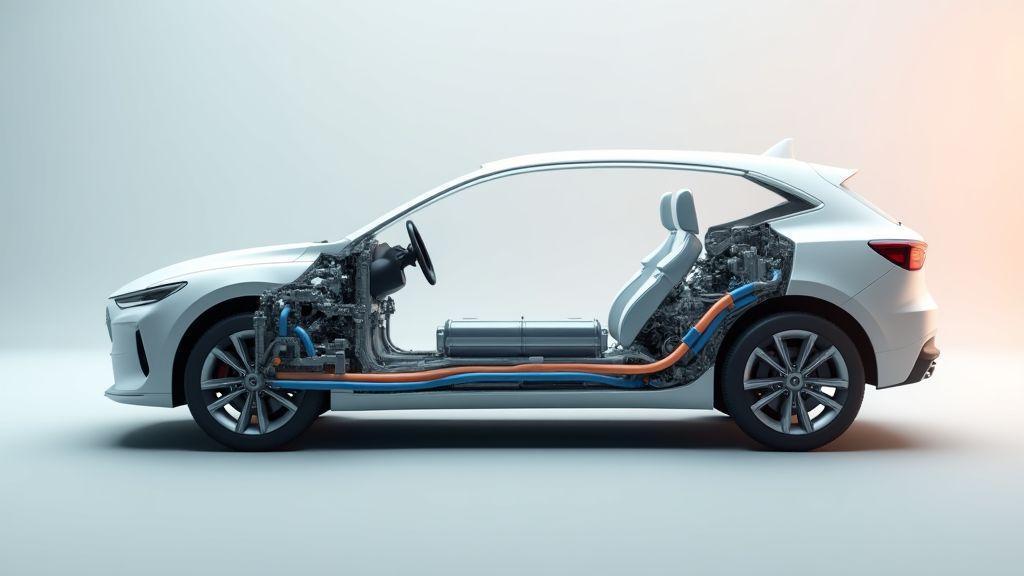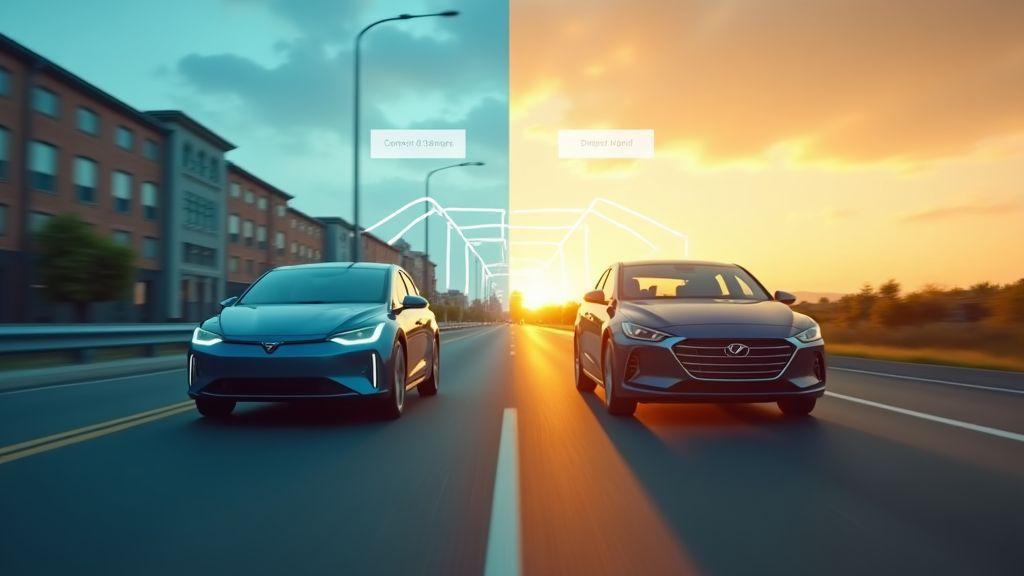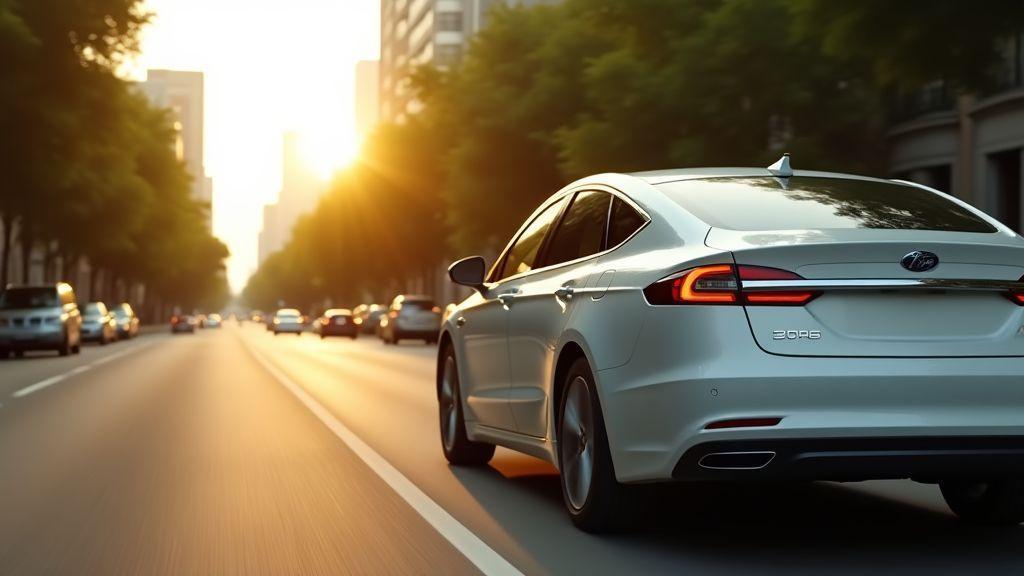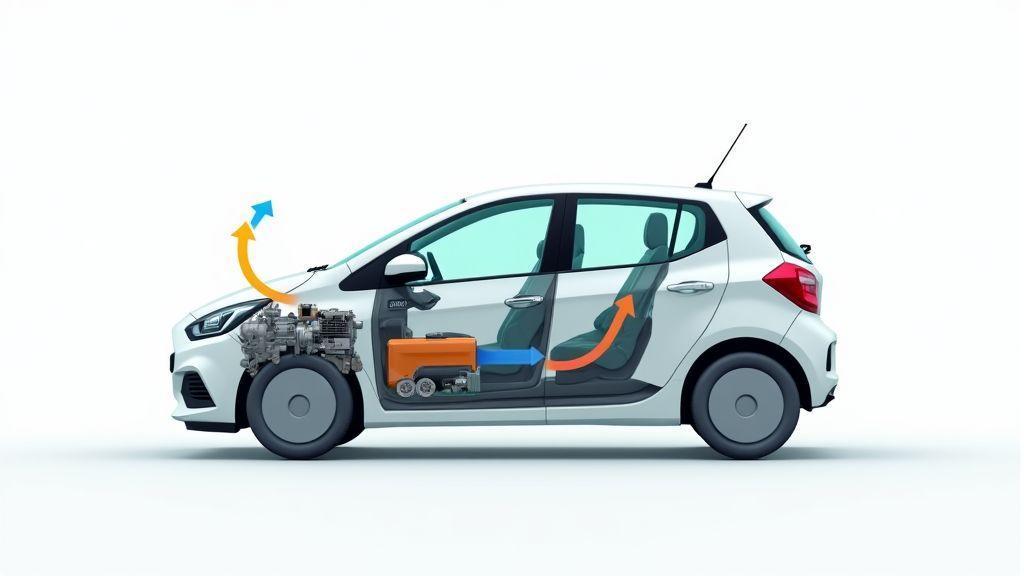How Hybrid Engines Work: A Beginner’s Guide
You will get a clear, simple tour of how the electric motor and gas engine share work, when your car runs on battery, gas, or both, and what to expect on city and highway trips. You’ll see the key parts: battery, motor, power electronics, generator, transmission, sensors and control units. You’ll learn the difference between series and parallel hybrids, how regenerative braking saves energy, and everyday benefits like better city fuel economy and lower emissions. Finally, get practical maintenance tips to protect your investment and know what warranties and service plans usually cover.
Key Takeaway
- You get power from both the gasoline engine and the electric motor.
- Your car saves fuel by using electric power at low speeds.
- Your battery stores energy from braking for later use.
- Your gas engine runs for long trips or when more power is needed.
- You reduce emissions and improve fuel economy.

How hybrid engines work: a simple overview for you
Hybrids pair two power sources: an internal combustion engine and an electric motor with a battery. Think of them like a two-person crew: one provides sustained power when you need it, the other handles low-speed moves and recovers energy when you slow down. This mix saves fuel and cuts emissions without changing how you drive.
The car’s control system decides which source to use. At low speeds the electric motor often takes the lead. When you push the pedal, the gas engine kicks in or both work together. Braking sends energy back to the battery through regenerative braking so the motor can help again. Expect quieter starts and better mileage in town; on long trips the gas engine does more of the heavy lifting.
If you want a concise primer, How Hybrid Engines Work: A Beginner’s Guide lays out the basics quickly. For an official overview, see the government primer on how hybrid vehicles work in practice.
How the electric motor and gas engine share work for you
The electric motor handles low-speed tasks and short bursts of acceleration, making stop-and-go traffic smooth and quiet. The gas engine covers steady high-speed driving and heavy loads like long hills or full cargo.
The switch between them is automatic and usually seamless. Sensors and software pick the most efficient setup. Typical operation:
- Start/idle: motor alone for silence and zero local emissions.
- Light acceleration or cruising: motor or gas depending on speed and battery.
- Heavy acceleration or high load: both work together for power.
- Braking: regenerative braking stores energy back to the battery.
When your car runs on battery, gas, or both
Most hybrids use the battery for city driving, short moves, and starts. The gas engine wakes up for highway speeds, steep climbs, or when the battery is low. Plug-in hybrids give you longer electric-only ranges before the gas engine is needed.
| Mode | Typical use | What to expect |
|---|---|---|
| Electric-only | City driving, short trips | Quiet, low emissions, limited range |
| Gas-only | Long highway runs, steep hills | Strong range, higher fuel use |
| Both together | Hard acceleration, full load | Best power, improved overtakes |
Your actual driving style changes the balance. Frequent braking and low-speed city driving increase electric use; long daily highway trips let the gas engine do most of the work.
What to expect on city and highway trips
In the city you’ll enjoy quiet starts and steady stop-and-go efficiency. Regenerative braking helps recharge the battery as you slow. On the highway expect smoother fuel economy than a pure gas car, but less electric-only time since the engine runs more to maintain speed.
Hybrid engine components explained so you can see each part
Think of this as How Hybrid Engines Work: A Beginner’s Guide for your garage. The main parts are easy to spot once you know what to look for: a high-voltage battery pack, an electric motor and inverter, a gasoline engine, a generator/starter, and a transmission that ties them together. Each part has a clear job, and they hand off power like runners in a relay race.
The battery stores energy like a tank and gives the motor the juice to move your car at low speeds or help the engine at higher speeds. The motor drives the wheels and acts as a generator during braking, turning motion back into stored energy. Power electronics sit between the battery and motor and act like a translator, turning DC into AC for the motor and conditioning current when charging.
Under the hood, the gasoline engine and transmission work with the electric parts to give steady speed and long range. The control units decide which source drives the wheels at any moment to keep your ride smooth and efficient. The US EPA also describes basic hybrid components and emissions benefits if you want more environmental context.
Your battery, electric motor, and power electronics roles
Your hybrid battery is built for many charge cycles. It stores energy from the engine and from braking. When you accelerate, the battery can add extra power so the engine doesn’t have to work as hard.
The electric motor delivers instant torque, so the car feels quick at low speeds. The inverter and power electronics manage voltage and current, converting battery DC to the AC the motor needs and controlling motor speed and torque. When you lift off the throttle, the motor flips to generator mode and feeds energy back to the battery.
- Battery → Inverter → Motor: the flow of electric power during drive and regen
| Component | What it does |
|---|---|
| Battery | Stores electrical energy for acceleration and holds regen charge |
| Inverter / Power electronics | Converts and controls voltage/current between battery and motor |
| Electric motor / Generator | Drives wheels and recovers energy during braking |
Your engine, generator, and transmission in a hybrid
The gasoline engine provides steady long-range power and can charge the battery when needed. The generator is often the same hardware as the starter motor or the motor acting in reverse; it charges the battery when the engine runs or during heavy braking. The transmission blends power from the engine and motor to the wheels. In some designs a power-split device or clutch arrangement lets the car use electric drive, engine drive, or both, with smooth handoffs.
How sensors and control units coordinate your power flow
Sensors read speed, throttle, battery state, brake pressure, and more, and send that data to control units. The control units act like an orchestra conductor, deciding when the motor or engine leads. They switch clutches, change inverter settings, and manage charging so your ride stays smooth and efficient.

Series vs parallel hybrid systems: choose what fits your driving
Series and parallel refer to how the engine, battery, and motor share the work. In a series hybrid, the engine spins a generator that makes electricity for the motor. In a parallel hybrid, the engine and motor can both push the wheels directly.
If you mostly do short city trips, a series setup feels like a quiet electric scooter with an onboard charger. If you drive long highway miles, a parallel setup acts like a beefed-up gas car with electric help when you need it. Consider trip length, traffic patterns, and how often you want to charge.
Checklist to pick what fits you:
- Choose series if you mainly drive in the city and want an electric-first feel.
- Choose parallel if you do long highway runs and want better top-end efficiency.
- Compare upfront cost, battery size, and maintenance for the models you consider.
| Feature | Series Hybrid | Parallel Hybrid |
|---|---|---|
| How engine power is used | Powers a generator; motor drives wheels | Engine and motor can both drive wheels |
| Best for | Stop-and-go city driving | Mixed or highway driving |
| Typical feel | Quiet, electric-like | Stronger acceleration at speed |
| Common trade-off | More conversion losses | More complex transmission |
How a series hybrid sends engine power to a generator then to a motor
In a series hybrid the engine never turns the wheels directly. The engine runs a generator that charges the battery or feeds the motor. This saves on heavy transmission hardware and lets the engine run at steady, efficient speeds—ideal for city driving, though conversion losses can reduce highway efficiency.
How a parallel hybrid lets engine and motor drive your wheels together
A parallel hybrid splits the job. The engine can drive the wheels and the electric motor can add power directly. When you floor it, both sources team up for strong acceleration. This setup often yields better highway efficiency at the cost of additional mechanical complexity.
Why makers pick series or parallel for fuel use and cost
Manufacturers balance fuel patterns, price, and customer taste. Series hybrids favor city efficiency and a simpler driving feel, while parallel designs save fuel at speed and sometimes reuse existing transmission tech to lower cost. Your savings depend on how you drive, fuel prices, and maintenance over time.
How regenerative braking works in hybrids to save energy for you
Regenerative braking turns forward motion into electricity. When you lift off the gas or press the brake, the electric motor flips to generator mode, slowing the wheels and pushing current back into the battery. This recovered energy cuts fuel use, especially in city driving with lots of stops.
The system needs a motor-generator, inverter, battery, and control software that decides when to use regen or friction brakes. Regen handles mild to moderate deceleration; for rapid stops or when the battery is full, the car blends in traditional brakes. Together they save fuel, lower emissions, and reduce pad and rotor wear.
If you want a starter resource, How Hybrid Engines Work: A Beginner’s Guide explains how these gains add up and why your MPG improves when regen is active. For a technical overview, see the Department of Energy’s overview of hybrid and electric systems.
How your car converts motion into battery charge when you brake
Your motor is also a generator: as the wheels turn the motor shaft during deceleration, a changing magnetic field produces current. The inverter conditions that current for the battery so the energy is stored and ready to power the car again.
There are limits and losses: not all kinetic energy becomes stored electricity—some is lost as heat. If the battery is full, regen may cut out and friction brakes take over. Gentle braking and coasting help you recover the most energy.
Steps in regen:
- You lift off or press the brake.
- Motor switches to generator mode and slows the wheels.
- Inverter conditions the electricity.
- Battery stores the recovered energy.
When regen braking reduces wear on your friction brakes
Regenerative braking handles a large share of everyday braking, so pads wear much slower. In town driving, where you brake often but not violently, the motor does most of the slowing. That reduces brake dust and service frequency.
Regen doesn’t replace friction brakes entirely—sharp stops, very low speeds, or a full battery require friction braking. Safety systems ensure you won’t lose stopping power; regen just takes routine load off and extends pad life.
| Aspect | Regenerative Braking | Friction Brakes |
|---|---|---|
| Energy fate | Stored in battery | Lost as heat |
| Wear on pads | Low | High |
| Best use | City, stop-and-go | Emergency stops, low-speed holds |
| Pedal feel | Can be smooth or grabby | Familiar, consistent bite |
How braking feel and pedal feedback may change for you
You may notice different pedal feel: some cars let you slow with one-pedal driving, others blend regen and friction for a more familiar feel. Practice in a quiet lot and try regen settings if available to find what feels right.

Benefits of hybrid engines you can expect in daily use
Hybrids give real, everyday perks. In town driving the electric motor handles low-speed moves and the petrol engine steps in when you need power. Expect fewer trips to the pump, quieter starts, and less idling at lights. Regenerative braking returns energy to the battery and reduces brake wear, lowering ownership costs over time.
How hybrid engines work to give better city fuel economy and lower emissions
The electric motor handles starts, low speeds, and short bursts while the petrol engine takes over for sustained high-speed or heavy loads. The control system chooses the best source at each moment—this teamwork is why hybrids shine in city traffic. Regenerative braking captures energy that would otherwise be lost, and the engine often shuts off at stops to reduce emissions.
| Scenario | Conventional (approx.) | Hybrid (approx.) |
|---|---|---|
| City fuel economy | 25 mpg | 45–55 mpg |
| Highway fuel economy | 35 mpg | 40–50 mpg |
How you can save on fuel and sometimes get tax or rebate perks
Fuel savings are the obvious win—you fill up less often because electric assist and start-stop keep the engine off when not needed. Depending on where you live, you may also get tax credits, rebates, lower registration fees, or HOV lane access. Common benefits:
- Lower annual fuel costs from better city MPG.
- Reduced brake and wear items thanks to regeneration.
- Tax credits, rebates, or lower fees in some regions.
- HOV lane access or parking incentives where available.
How the hybrid powertrain helps your long-term running costs
A hybrid spreads the workload between electric and petrol systems, reducing engine stress and prolonging major components. Batteries often come with long warranties and many last beyond that in real use. When you add lower fuel use and cheaper wear items, the higher purchase price can be balanced by lower running costs and often better resale.
Hybrid car maintenance tips for beginners to protect your investment
You bought a hybrid for better fuel economy and lower emissions. Small habits save big money: schedule regular checkups, keep a service record, and learn the basics of how your hybrid operates. Read the owner’s manual and consult resources on our site’s home page for model-specific guides.
Drive gently—smooth acceleration and coasting save battery and brakes. Short trips in cold weather stress the battery and engine, so plan maintenance more often if that’s your routine. For practical, general guidance on service items and inspections, see this Car Care Council resource on maintaining your hybrid battery and brakes.
How to care for your hybrid battery, cooling system, and power electronics
Keep the battery cool and within normal charge ranges. Avoid extreme charge swings daily. In hot or cold climates, park in shade or a garage when possible. Check coolant levels at intervals and keep air intakes and vents clear of debris. If you hear unusual noises or see performance drops, have the electronics and cooling flow inspected.
Routine checks you should do: brakes, oil, tyres, and software updates
Brakes wear differently in hybrids—check pads and rotors regularly for uneven wear. Check brake fluid and replace per the manual. Also check oil, tyres, and software updates; many hybrids receive OTA updates that improve efficiency and fix bugs. Verify software is up to date via the car’s menu or dealer, and review data and update practices on our privacy page.
Monthly checklist:
- Check tyre pressure and tread.
- Look at oil level and top off if low.
- Inspect brake pads visually or note any warning sounds.
- Verify software is up to date via the car’s menu or dealer.
- Clear debris from grille and battery vents.
What warranties and service plans usually cover
Most hybrids come with a standard vehicle warranty and a separate hybrid battery/high-voltage component warranty. Battery coverage typically runs longer than general warranty and may include replacement if capacity falls below a set percentage. Routine wear items are usually not covered unless a specific plan includes them. Keep service receipts and review the terms of use and warranty details for any service plan.
| Component | Typical Coverage | Notes |
|---|---|---|
| General vehicle warranty | 3–5 years | Covers engine, transmission, many systems |
| Hybrid battery / HV components | 8–10 years or 100,000–150,000 miles | Varies by manufacturer and region |
| Emissions / state-mandated coverage | Varies | May extend battery coverage in some states |
| Routine maintenance | Not covered unless in plan | Some dealers sell prepaid service plans |
Conclusion
You now have a clear map: hybrids pair a gas engine and an electric motor so they share the load like a well-drilled relay team. The battery stores energy—often reclaimed through regenerative braking—and the control systems decide when the car runs on battery, gas, or both. Knowing the difference between series and parallel layouts helps you match a car to your driving habits.
Expect quiet, efficient city driving and reliable performance on long trips. Everyday wins include better city fuel economy, lower emissions, quieter starts, and reduced brake wear—but the payoff depends on your driving and care.
Protect that payoff: read the owner’s manual, follow key maintenance tips, keep cooling and vents clear, check tyres and oil, accept software updates, keep service records, and understand warranties for battery and high-voltage components.
For detailed questions or local service referrals, visit our contact page. Read more articles and guides on the Meridian Pioneer home page.

